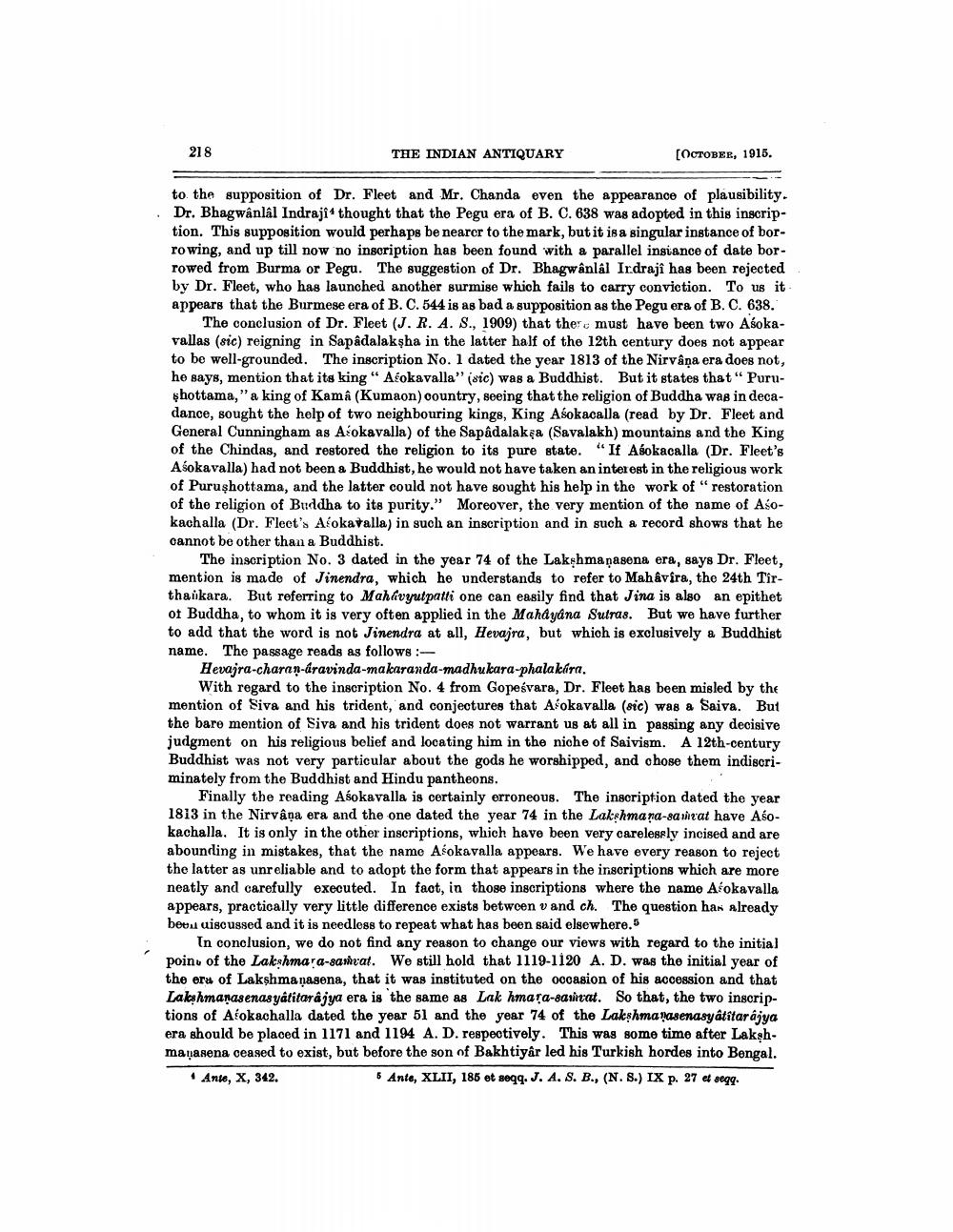________________
218
THE INDIAN ANTIQUARY
[OCTOBER, 1915.
to the supposition of Dr. Fleet and Mr. Chanda even the appearance of plausibility. Dr. Bhagwânlal Indrajit thought that the Pegu era of B. C. 638 was adopted in this inscription. This supposition would perhaps be nearer to the mark, but it is a singular instance of borrowing, and up till now no inscription has been found with a parallel insiance of date borrowed from Burma or Pegu. The suggestion of Dr. Bhagwânlal Ir.draji has been rejected by Dr. Fleet, who has launched another surmise which fails to carry conviction. To us it appears that the Burmese era of B. C. 544 is as bad a supposition as the Pegu era of B. C. 638.
The conclusion of Dr. Fleet (J. R. A. S., 1909) that there must have been two Asokavallas (sic) reigning in Sapadalaksha in the latter half of the 12th century does not appear to be well-grounded. The inscription No. 1 dated the year 1813 of the Nirvana era does not, he says, mention that its king " Asokavalla" (sic) was a Buddhist. But it states that " Purushottama," a king of Kama (Kumaon) country, seeing that the religion of Buddha was in decadance, sought the help of two neighbouring kings, King Asokacalla (read by Dr. Fleet and General Cunningham as Asokavalla) of the Sapädalakea (Savalakh) mountains and the King of the Chindas, and restored the religion to its pure state. "If Asokacalla (Dr. Fleet's Asokavalla) had not been a Buddhist, he would not have taken an interest in the religious work of Purushottama, and the latter could not have sought his help in the work of "restoration of the religion of Buddha to its purity.” Moreover, the very mention of the name of Asokachalla (Dr. Fleet's Asokatalla) in such an inscription and in such a record shows that he cannot be other than a Buddhist.
The inscription No. 3 dated in the year 74 of the Lakshmaṇasena era, says Dr. Fleet, mention is made of Jinendra, which he understands to refer to Mahavira, the 24th Tirthaikara. But referring to Mahkvyutpatti one can easily find that Jina is also an epithet of Buddha, to whom it is very often applied in the Mahayana Sutras. But we have further to add that the word is not Jinendra at all, Hevajra, but which is exclusively a Buddhist name. The passage reads as follows:
Hevajra-charan-dravinda-makaranda-madhukara-phalakara.
With regard to the inscription No. 4 from Gopeśvara, Dr. Fleet has been misled by the mention of Siva and his trident, and conjectures that Asokavalla (sic) was a Saiva. But the bare mention of Siva and his trident does not warrant us at all in passing any decisive judgment on his religious belief and locating him in the niche of Saivism. A 12th-century Buddhist was not very particular about the gods he worshipped, and chose them indiscriminately from the Buddhist and Hindu pantheons.
Finally the reading Asokavalla is certainly erroneous. The inscription dated the year 1813 in the Nirvana era and the one dated the year 74 in the Lakshmana-saiat have Asokachalla. It is only in the other inscriptions, which have been very carelessly incised and are abounding in mistakes, that the name Asokavalla appears. We have every reason to reject the latter as unreliable and to adopt the form that appears in the inscriptions which are more neatly and carefully executed. In fact, in those inscriptions where the name Asokavalla appears, practically very little difference exists between v and ch. The question has already beun uiscussed and it is needless to repeat what has been said elsewhere.5
In conclusion, we do not find any reason to change our views with regard to the initial point of the Lakshmara-samat. We still hold that 1119-1120 A. D. was the initial year of the era of Lakshmaṇasena, that it was instituted on the occasion of his accession and that Lakshmanasenasyalitarajya era is the same as Lak hmara-sanitat. So that, the two inscriptions of Asokachalla dated the year 51 and the year 74 of the Lakshmanasenasyatîtarajya era should be placed in 1171 and 1194 A. D. respectively. This was some time after Lakshmanasena ceased to exist, but before the son of Bakhtiyar led his Turkish hordes into Bengal. + Ante, x, 342.
6 Anto, XLII, 186 et seqq. J. A. S. B., (N. 8.) IX p. 27 et seqq.




